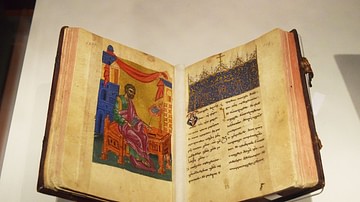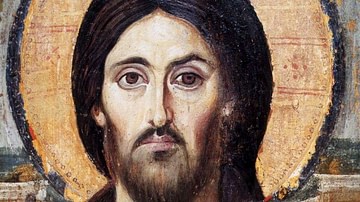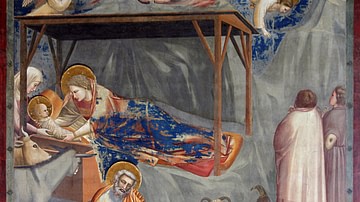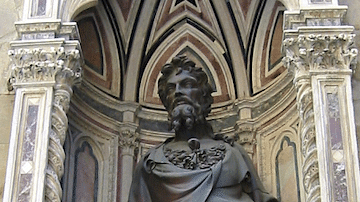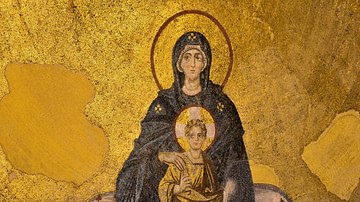This article is a source-critical Analysis of Mark 4:30-32, Luke 13:18-19, Matt. 13:31b-32 and G.Thom. 20:1-2, otherwise know as the parable of the Mustard Seed. On first comparison we see that all three synoptic texts agree on the essence of the parable but none are identical. All three texts discuss the kingdom of God in likeness to a mustard seed which could be a proverbial metaphor for something large that comes from very little.
In essence, all three synoptic versions recount the same parable, referring to the kingdom as 'like a grain of mustard seed.' This seed when sown grew into a great plant in which the 'birds of the air' could make nests. Each version though differs in its details and even parallels contain variations in the Greek language between accounts. Matthew, Mark and Thomas make the claim that the mustard seed is 'the smallest of all seeds' with slight differentiation to the Greek sentence structure. This is a claim not made in Luke's shorter version of the parable.
There are some considerable differences between and within the synoptic and Thomas' versions. Mark's account is clearly the longest in Greek while Luke's and Thomas' are the shortest. In turn, the introduction to Luke's is longer than Matthew's. The forms of the accounts also differ in relation to the introductions. Luke and Mark both begin with a pair of rhetorical questions. While Matthew does not follow suit he does, like Luke and Mark, place the introduction of the parable in the mouth of Jesus unlike Thomas who has the disciples initiate the parable by asking Jesus to 'Tell us what the Kingdom of Heaven is like.'
What appears the most obvious difference though is the variation in the details of the texts. The nature of the seed's growth and form is described differently by all form versions. Mark chooses to describe it as a great shrub, which is the most realistic outcome concerning a mustard seed. Luke and Matthew choose to describe it as a tree, but Matthew also calls it the greatest of all shrubs which parallels Mark's wording. Thomas creates a more general image, describing it as a 'great plant.' Thomas' description also holds some realism as it recounts the birds sheltering under the plant which would occur in the case of a mustard plant. In this way, among others, Thomas' account most closely parallels Mark's version.
While all versions allude to the birds of the air making use of the plant, the way that this occurs differs between accounts. Matthew and Luke, alluding to their conclusion that the seed becomes a tree, state that the birds come and make nests in its branches. Thomas and Mark place emphasis rather on the shelter which the 'shrub' provides for the birds, though Mark does use the term branches in describing the growth of the shrub.
Mark again proves the closest parallel to Thomas in reference to the sowing of the mustard seed. Mark makes little comment of the sowing action and refers only to the seed as 'when sown upon the ground' which is the closest parallel to Thomas' 'when it falls on tilled soil.' Luke and Matthew place a greater emphasis on the sowing action by adding a human element which could act as a catalyst by which the 'tree' is grown. Matthew tells of a man who took and sowed it in his field. Luke tells of a man who took and sowed the seed in his garden. Mark places a greater emphasis on the state of the seed shown in his excessive use of adjectives and superlatives. In this point we see a parallel between Matthew and Luke which cannot be paralleled by either Thomas or Mark. This is implicit of another source being used by Luke and Matthew.
It is interesting to note that Mark and Luke both share details with Matthew but not with each other. For instance, the contrast between the seed and the shrub emphasised in Mark and Matthew, is not seen in Luke. The growth of the tree is seen in Matthew and Luke but not in Mark. Luke is independent from the other versions also because it presents the parable in a narrative context. This is seen clearly in the use of the past tense where Mark, Matthew and Thomas use the present.
Considering the similarities and differences that occur throughout the four versions of the Parable of the Mustard Seed, an explanation is necessary. It appears that the parable is an example of the two-source hypothesis which promotes the use of Mark and Q plus unique sources by Luke and Matthew. Matthew and Luke both have parallels in Mark but they also contain similarities that allude to access to at least one separate source. Thomas shows a Markan priority and does not appear to have access to the Q source in relation to the mustard seed parable. Luke presents an almost entirely Q version of the parable while Matthew attempts to merge the Markan and Q versions.
Matthew is indicative of Markan priority though Matthew converts Mark's comparison to a story form while retaining Mark's botanical addition. Markan priority throughout the gospel is witnessed in his omission of a mere fifty-five Markan verses. There is also a marked use of Q which is emphasised in the use of narrative. In turn, there is an amalgamation of source material and form in Matthew of Mark and Q. Matthew is an incomplete narrative because he maintains the narrative of the man sowing the seed attributed to Q but ends in a Markan general statement. Luke is independent in this respect as he does not conclude with a general statement regarding Jesus' use of parables.
The Jewish character in Matthew's text is seen throughout the gospel as Matthew sees no need for explanations of Jewish customs. Matthew's gospel presents itself like a teaching tool, a manual. It is interesting to note that, despite independent motives, Matthew retains an addition in Mark to explain the significance of the seed to the Gentile audience, 'the smallest of all seeds.'
Luke uses Mark and the Q source. In turn, Luke appears to reproduce a version more true to the Q source. The mustard seed parable lands within a chunk of the Lukan gospel which is specifically taken from Q (9:51-18:14). Thomas on the other hand reflects the Markan source almost entirely. Luke's introduction expresses a wish to present an orderly narrative which would benefit those who have some knowledge already about the Christian faith. He attempts to narrate the story of Jesus as historical. Luke also has a considerable amount of further information from unknown sources.
The use of the Q source is seen in the mention of the man in Matthew and Luke which does not appear in Mark. The Q source mentions άνθρωπος towards the beginning of the parable before ignoring him and changing the focus to directly lie on the mustard seed. In fact at this point of the text in Matthew and Luke, both appear to take their Greek account straight from Q which would account for the same Greek, ...κόκκω σινάπεως, όν λαβών άνθρωπος...(Matt. 13:31; Luke 13:19).
The use of a separate source by Matthew and Luke is also seen in the parallels concerning the tree (δένδρον) and κατασκηνοῦ εν τοῖς κλάδοις αυτοῦ (Matt.13:32) /κατεσκήνωσεν εν τοῖς κλάδοις αυτοῦ (Luke 13:19). The choice between 'shrub' and 'tree' is implicit of sources chosen by the gospel authors. The Markan version clearly states that the seed became a shrub which is directly paralleled in Thomas. This is exemplar of Thomas' use of Mark. Luke's decision to use 'tree' reiterates that Luke is usually believed to reproduce a Q form of the parable. This point is an example of the Mark-Q overlap because Matthew represents a mix of Markan and Q forms with the extension of the shrub idea into that of the tree; this is a classic trait in Matthew. The addition of the tree found in Matthew and Luke alludes to Old Testament roots. The tree in Daniel 4:10-4:27 refers similarly to a kingdom. Mark's uses of Old Testament allusions are fairly few which is implicit of a Roman audience.
It is difficult to assert the sources which Mark used to compose any of his gospel, let alone the Mustard seed parable. Form-critics have postulated the existence of comparatively small tradition cycles, oral traditions that date prior to the written gospel. There are also theories pertaining to the idea that Mark's gospel was formed from preaching.
The different tenses are indicative of separate sources as well as the differing motives of the authors. From the use of the narrative form in Luke we can surmise that Q was presented in the past tense while Mark is expressed in the present. The contrast involved in the line 'smaller than all the seeds on the earth' also makes a case for use of Q by Matthew and Luke. Mark explicitly states the contrast whereas Q leaves it implicit. This would account for the contrast not appearing in the Lukan version. Luke saw himself as a historical writer which may account for him not needing the explanation; he wrote for those with some prior knowledge so he could make his versions shorter and sharper.
The Gospel of Thomas appears dependent on Mark as it shows many of the Markan features. It does not appear to have any influence from Q like Luke or Matthew though it may have dealt with an independent source and its choice of words sometimes differs. For instance, 'birds of the air' becomes 'birds of the sky' and 'the greatest of all shrubs' becomes 'a great plant.' This may exhibit though, Thomas' choice of audience and way of writing rather than his choice of sources. Thomas like Mark engages in a more realistic description of the plant and how the birds shelter under it. The omission of the farmer is indicative of the lack of the Q source.

